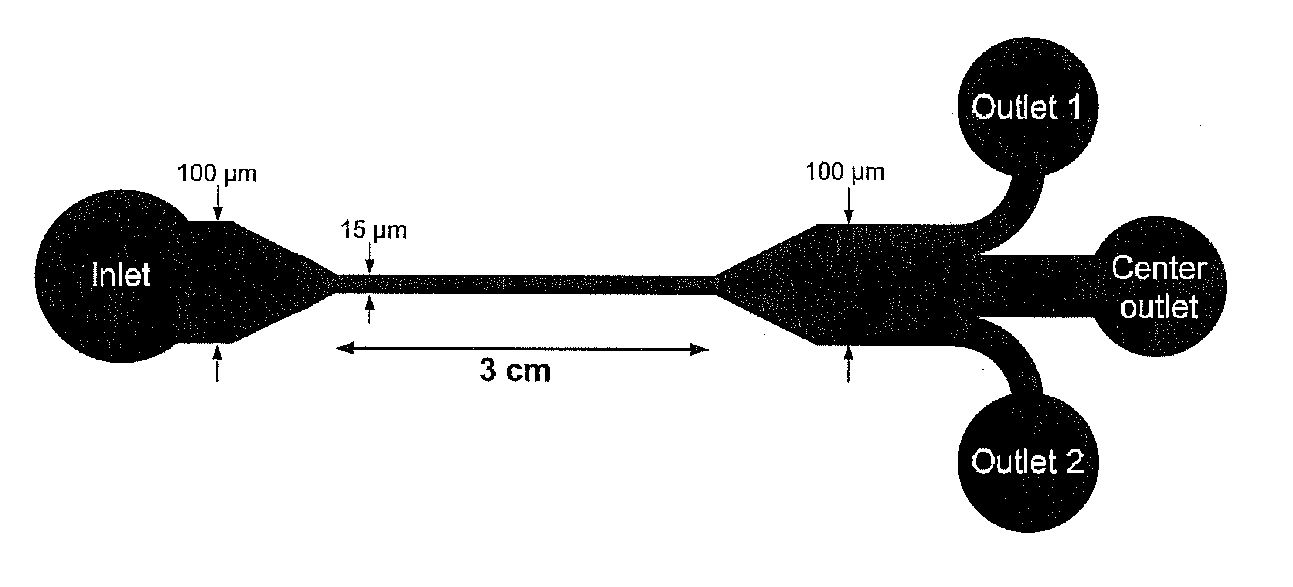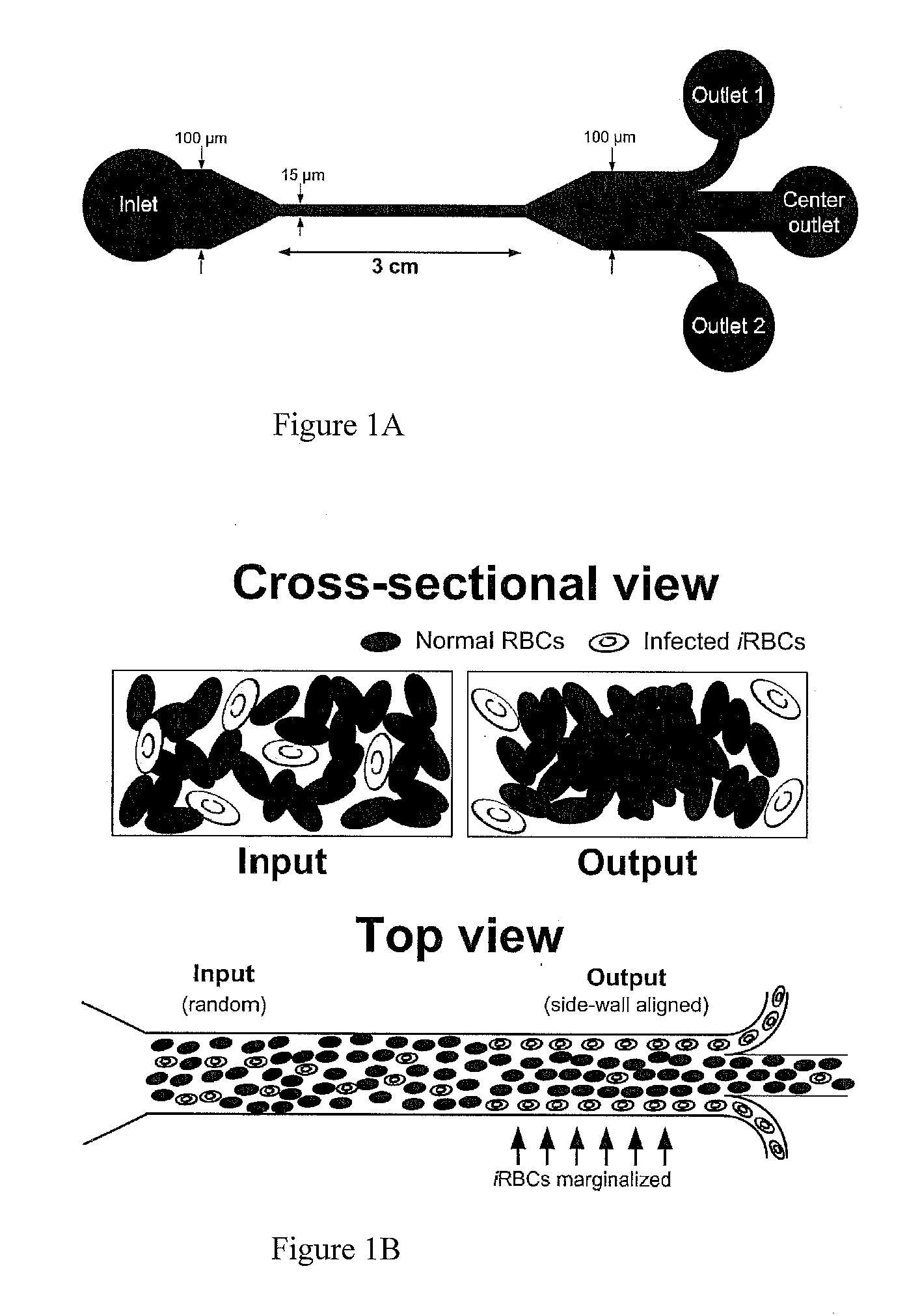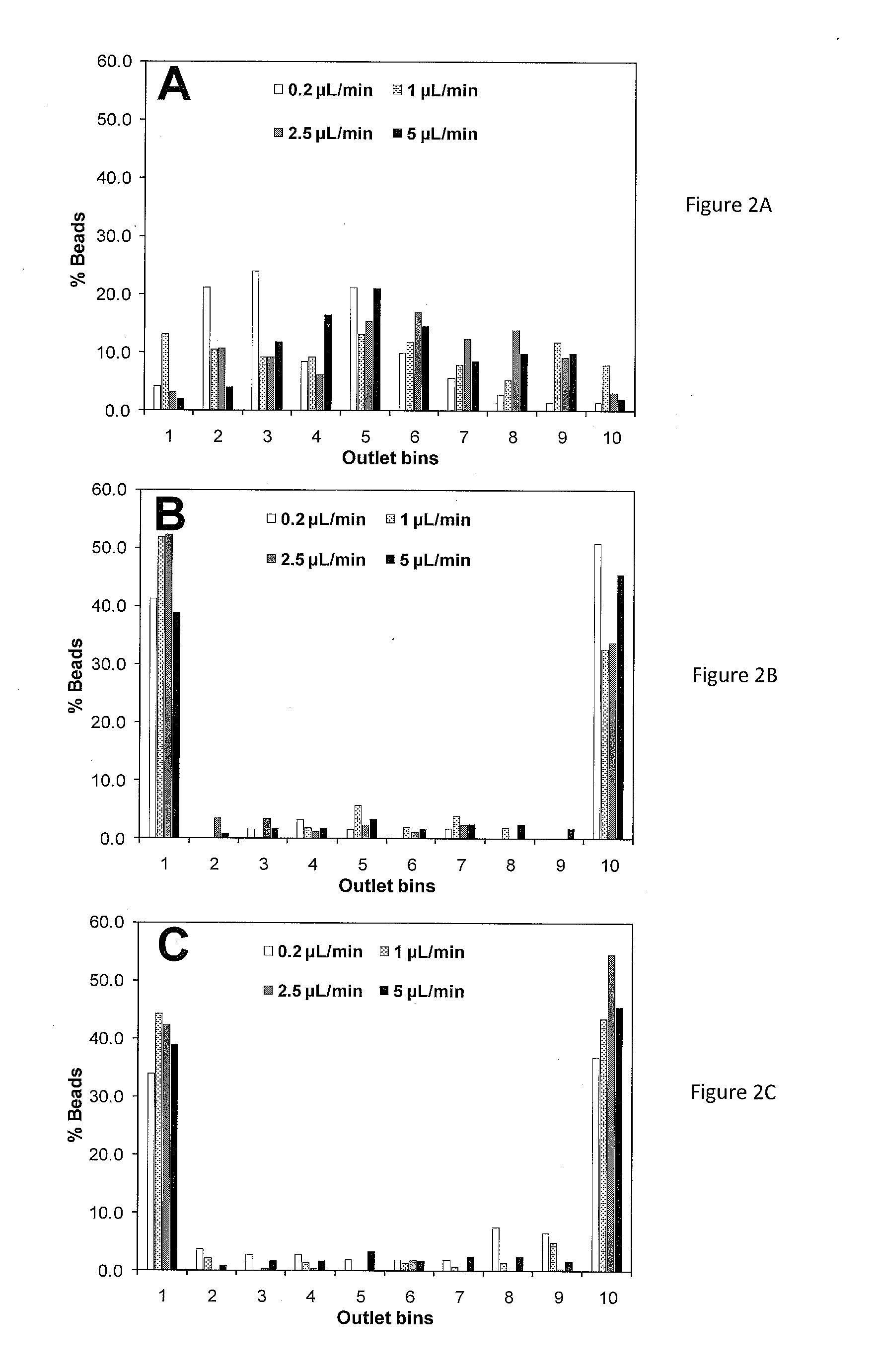Microfluidics Sorter For Cell Detection And Isolation
a cell detection and cell technology, applied in biochemistry apparatus and processes, laboratory glassware, instruments, etc., can solve the problems of unsuitable clinical blood sample processing and low processing throughput, and achieve the effect of reducing processing time and cost, high flow rate, and faster processing of clinical samples
- Summary
- Abstract
- Description
- Claims
- Application Information
AI Technical Summary
Benefits of technology
Problems solved by technology
Method used
Image
Examples
example 1
Deformability Based Sorting for Cell Separation and Isolation
Materials and Methods
Malaria Culture
[0076]P. falciparum 3D7 strain was used in this study. Parasites were cultured in RPMI medium 1640 (Invitrogen, USA) supplemented with 0.3 g of L-glutamine, 5 g of AlbuMAX II (Invitrogen, USA), 2 g NaHCO3, and 0.05 g of hypoxanthine (Sigma-Aldrich, USA) dissolved in 1 ml of 1 M NaOH, together with 1 ml of 10 mg / ml of Gentamicin (Invitrogen, USA). Parasites were synchronized at ring stage using 2.5% sorbitol to maintain a synchronous culture. Cultures were stored at 37° C. after gassing with a 5% CO2, 3% O2 and 92% N2 gas mixture and their hematocrit maintained at 2.5%. Cells were harvested at the ring stage, late trophozoite and schizont stage. Whole blood for parasite culture was obtained from healthy donors and was spun down to separate the RBCs. The RBC pellet was treated with CPDA for 3 days before being washed three times with RPMI 1640 and stored for use.
[0077]The...
example 2
Cell Cycle Synchronization in Spiral Microfluidics
Materials and Methods
Cell Culture
[0091]Mesenchymal stem cells (Lonza, Switzerland) were cultured in low-glucose Dulbecco's modified Eagle's medium (DMEM) (Invitrogen, USA) supplemented with 10% fetal bovine serum (FBS) (Invitrogen, USA) together with 1% penicillin-streptomycin (Invitrogen, USA). The Chinese hamster ovary cells transfected with human CD36, CHO-CD36 (ATCC, USA), were cultured in RPMI 1640 medium (Invitrogen, USA) supplemented with 10% FBS together with 1% penicillin-streptomycin. The cervical cancer cells HeLa (CCL-2™, ATCC, USA) were cultured in low-glucose DMEM supplemented with 10% FBS and 1% penicillin-streptomycin. The cholangiocarcinoma cell line, KKU-100 (received as a gift), were cultured in Ham's F-12 medium containing 10% FBS, 3% HEPES buffer and 1% penicillin-streptomycin. All cultures were maintained at 37° C. in a humidified atmosphere containing 5% (v / v) CO2. The MSCs were seeded at 500 cells / cm2 and cult...
example 3
Shear Modulated Abstraction of Rare-Cells Technology Biochip for High Throughput Isolation of Circulating Tumor Cells
Materials and Methods
Cell Culture and Sample Preparation
[0112]Two human breast adenocarcinoma cell lines, MCF-7 and MDA-MB-231, were tested in this work. The MCF-7 cells (HTB-22™, ATCC, USA) and MDA-MB-231 cells (HTB-26™, ATCC, USA) were cultured in low-glucose Dulbecco's modified Eagle's medium (DMEM) (Invitrogen, USA) supplemented with 10% fetal bovine serum (FBS) (Invitrogen, USA) together with 1% penicillin-streptomycin (Invitrogen, USA). The culture was maintained at 37° C. in a humidified atmosphere containing 5% (v / v) CO2. The cells were cultured in sterile 25 cm2 flasks (Corning) and subcultivated (1:4) three times a week with media replaced every 48 h. Sub-confluent monolayers were dissociated using 0.01% trypsin and 5.3 mM EDTA solution (Lonza, Switzerland). For the control and recovery experiments, the cancer cells were diluted in buffer containing 1× phosp...
PUM
| Property | Measurement | Unit |
|---|---|---|
| height | aaaaa | aaaaa |
| height | aaaaa | aaaaa |
| height | aaaaa | aaaaa |
Abstract
Description
Claims
Application Information
 Login to View More
Login to View More - R&D
- Intellectual Property
- Life Sciences
- Materials
- Tech Scout
- Unparalleled Data Quality
- Higher Quality Content
- 60% Fewer Hallucinations
Browse by: Latest US Patents, China's latest patents, Technical Efficacy Thesaurus, Application Domain, Technology Topic, Popular Technical Reports.
© 2025 PatSnap. All rights reserved.Legal|Privacy policy|Modern Slavery Act Transparency Statement|Sitemap|About US| Contact US: help@patsnap.com



